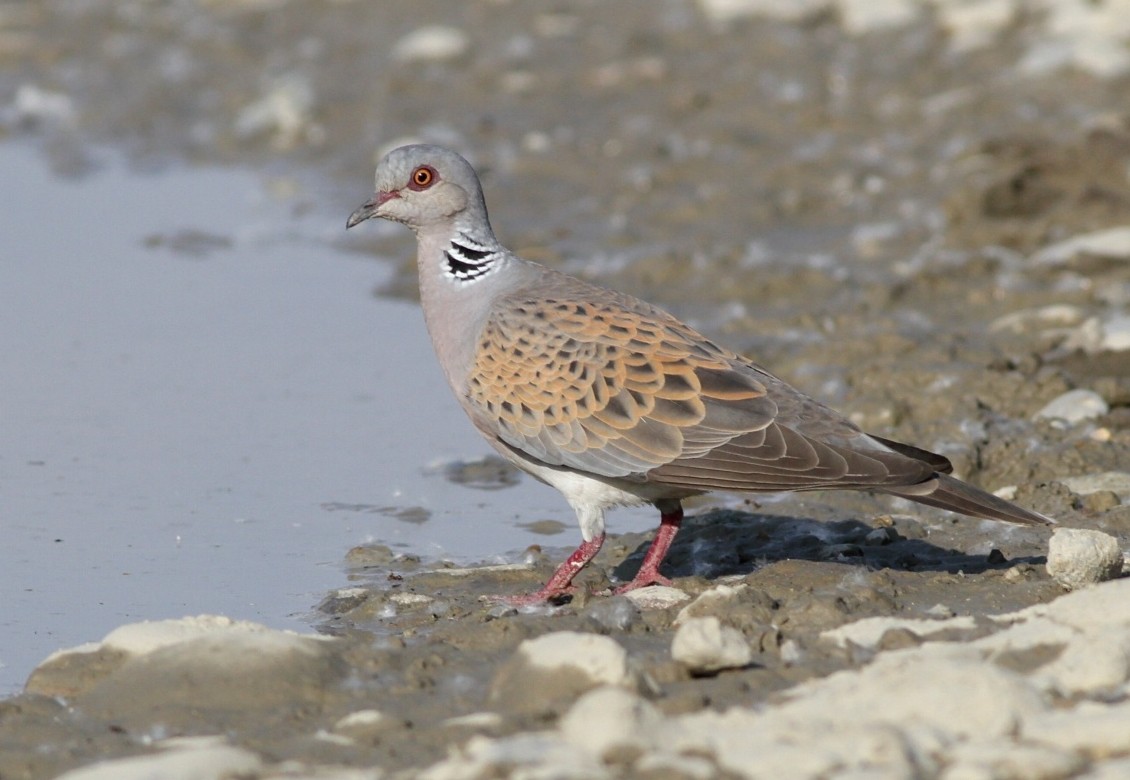European Turtle-dove
A species of Turtle-doves and Collared-doves Scientific name : Streptopelia turtur Genus : Turtle-doves and Collared-doves
European Turtle-dove, A species of Turtle-doves and Collared-doves
Botanical name: Streptopelia turtur
Genus: Turtle-doves and Collared-doves
Content
Description People often ask General Info
Description
Smaller and slighter in build than many other doves, it measures 26–28 cm (10–11 in) in length, 47–53 cm (19–21 in) in wingspan and weighs 100–156 g (3.5–5.5 oz). The European turtle dove may be recognised by its browner colour, and the black-and-white-striped patch on the side of its neck. The tail is notable as the bird flies from the observer; it is wedge shaped, with a dark centre and white borders and tips. When viewed from below, this pattern, owing to the white under-tail coverts obscuring the dark bases, is a blackish chevron on a white ground. This can be seen when the bird stoops to drink and raises its spread tail. The mature bird has the head, neck, flanks, and rump blue grey, and the wings cinnamon, mottled with black. The breast is vinaceous, the abdomen and under tail coverts are white. The bill is black, the legs and eye rims are red. The black and white patch on the side of the neck is absent in the browner and duller juvenile bird, which also has the legs brown. 
Size
29 cm
Colors
Brown
Black
Bronze
Gray
White
Blue
Orange
Life Expectancy
13 years
Nest Placement
Tree
Feeding Habits
European Turtle-dove's diet consists mainly of seeds, fruits, and invertebrates. They exhibit foraging behaviors, searching for food mostly on the ground. A unique adaptation of european Turtle-dove is their preference for certain seed types during breeding season to meet increased nutritional needs.
Habitat
European Turtle-dove occupies diverse woodland environments, primarily along forest edges, open woodlands, and heathlands with trees. Its preferred habitats include sunny, dry, and sheltered areas below 350 m altitude in Europe, and up to 1300 m in southern parts. In North Africa, the species resides in oak forests, groves, and oases. During winter, european Turtle-dove frequents Acacia and Combretum savannas and coastal bushes, requiring seed-rich areas for nesting and fledgling survival.
Dite type
Granivorous
People often ask
General Info
Feeding Habits
Bird food type
Bird Feeder Type

Platform
Distribution Area
The turtle dove is a migratory species with a western Palearctic range covering most of Europe and the Middle East and including Turkey and north Africa, although it is rare in northern Scandinavia and Russia. It winters south of the Sahara. The turtle dove, one of the latest migrants, rarely appears in Northern Europe before the end of April, returning south again in September. It is a bird of open rather than dense woodlands, and frequently feeds on the ground. It will occasionally nest in large gardens, but is usually extremely timid, probably due to the heavy hunting pressure it faces during migration. The flight is often described as arrowy, but is not remarkably swift. The nuptial flight, high and circling, is like that of the common wood pigeon, but the undulations are less decided; it is accompanied by the whip-crack of the downward flicked wings. The arrival in spring is heralded by its cooing or purring song, a rather deep, vibrating “turrr, turrr”. 
Species Status
Not globally threatened.
